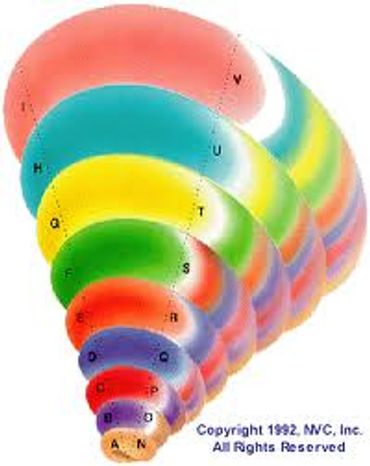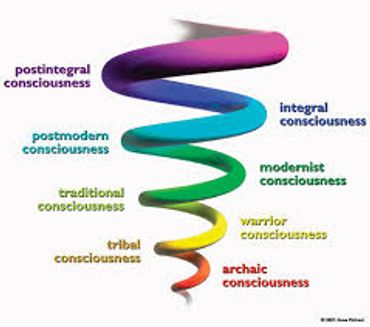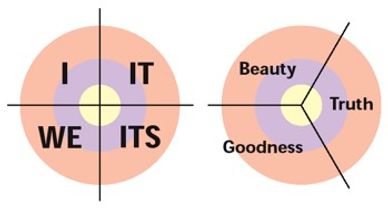what is your worldview?

How do you see the world?
Is the world ...
- a balanced system of interlocking forces? (Turquoise*)
- a healthy chaotic organism forged by differences and change? (Yellow)
- a human community in which we share life’s experiences? (Green)
- a game and market place full of possibilities and opportunities for success? (Orange)
- a test based on one ultimate truth resulting in pass / fail? (Blue)
- a jungle and a battle to win or lose? (Red)
- magical connections and superstitions? (Purple)
- instinctual survival, life or death? (Beige)
(*Spiral Dynamics colors)
integral theory & spiral dynamics

Keep in mind...
History isn’t what happened.
It’s who tells the story.
~ Sally Roesch Wagner, historian of women’s history and Native American history
Integral Theory & Ken Wilber
Integral theory is a theory integrating over 100 ancient and contemporary evolutionary and developmental theories and thinkers into one single framework. Philosopher Ken Wilber calls it the "theory of everything" (matter, body, mind, soul, and spirit), synthesizing eastern religious traditions with western structural stage theories and psychological models of development.
Wilber’s Integral “AQAL” model stands for all quadrants, all levels, all lines, all states, and all types. These 5 elements represent all the aspects that can describe individual and group experiences. It enables the selection the most relevant and effective strategies for responding to particular life circumstances.
Quadrants - 4 different perspectives of 'subjective and objective' and 'individual and collective'; info below
Levels - the evolution and development of higher levels of values and self-identity; info below
Lines - areas of intelligence including IQ, mathematical, spatial, linguistic, kinesthetic, musical, interpersonal, intrapersonal, emotional, among others that can be found on the internet
States - states such as conscious wakefulness, unconsciousness, subconsciousness, dream state, among others that can be found on the internet
Types - includes M/F/LGBTQ+ paradigms and personality typologies including the Enneagram (see the Enneagram+Levels chart at bottom of this page and the Enneagram page here on Deep Intention).
More information under Theories below.
Spiral Dynamics & Don Beck
Spiral Dynamics (SD) is a model of the evolutionary development of individuals, organizations, and societies. It was developed by Don Edward Beck and Christopher Cowan based on Clare W. Graves' emergent cyclical theory of adult human development. According to Robin Lincoln Wood, "It is the theory and practice of WHY people, including ourselves, do things, and how we make meaning. Is there an ultimate WHY? If so, how can we know?"
Spiral Dynamics Integral (SDi) expands the understanding of the “values line” and how this can be understood in individuals and communities.
Note, both Integral Theory and Spiral Dynamics use color themes for the levels, but they do not use the same color themes.
More information under Theories below.
Consciousness & Jean Gebser
Gebser's major thesis was that human consciousness is in transition, and that these transitions are "mutations" and that they are not continuous. These jumps or transformations involve structural changes in both mind and body. Both the past and the future - along with all the mutations (ie structures), are latently present in the present of all of us. Gebser held that previous consciousness structures continue to operate parallel to the emergent structure. Consciousness is "presence" itself. Gebser's major work is The Ever-Present Origin.
See also Jeremy Johnson's Seeing Through the World - Jean Gebser and Integral Consciousness (great book, must read).
Levels | Quadrants | Types
what do the levels of evolution & development look like?








theories of developmental levels (different color schemes)

Integral Theory
Ken Wilber's Integral Levels of Development
Notice the colors on the left side of the chart are configured like a rainbow.
Spiral Dynamics
Don Beck's Spiral Dynamics Levels of Development
Notice the different color presentation on the right side of the chart.
Graves' chart of Levels of Existence
Spiral Dynamics is based on the work of Clare W. Graves.
Development of the Human Brain
Human Brain
- Physical brain: 5 senses
- Emotional brain: interpersonal info and pattern recognition
- Intellectual brain: time and space, abstract concepts
Pre/Trans Fallacy
So exactly which level are we talking about?
Who is correct? Gramma, the 10 year old, or the toddler?
Start by asking a simple Yes/No question. For instance, "Do you believe in Santa Claus?" At the lower level of pre-conventional development, a 3 year old will shout, "Yes, and I've been a good boy, and Santa is going to bring me a train!" The little boy's 10 year old sister, who is at the conventional level of development, will say, "Nooo, there's no Santa Claus. It was just daddy dressed up like Santa Claus." Gramma at the higher trans-conventional level of development will say, "Of course I believe in Santa - he exemplifies the goodness and generosity of people's hearts, which we never should give up hope on."
So. There are 2 "Yes's." Are they the same though? In this Santa Claus example it's easy to see the difference in the toddler's Yes and the Gramma's Yes. The toddler cannot be mistaken for an enlightened being, and Gramma (hopefully) hasn't lost her marbles.
In more serious examples, such as, "Do you support the draft?," the answers get more challenging to interpret. The pre-conventional love-in hippies of the 60s said, "No draft! I can do whatever I want with my own body. Make love, not war." The conventional people said, "Yes, the draft is the law, and we must follow the law." A few trans-conventional thinkers said, "No, I do not believe in the war or the draft, and here are my nuanced and well-thought-out reasons."
There are 2 "No's," but they are definitely not the same. What happened in the 60s was the mixing up of the pre-con hippies who thought they were all enlightened and the trans-con nuanced thinkers who ended up being denigrated by the public as juvenile hippies. Being a youthful, passionate hippie at that time myself, I find this example useful.
The bottom line is we humans need to be discerning listeners and thinkers.
Note: some authors use the term post-conventional; some trans-conventional.
Testimonial for Martin Ucik's Integral Relationship course
In an Integral Relationship, couples bring 14 essential elements into a functional whole for the co-creation of a healthy, sustainable love relationship. Integral Love Relationships build on the insight that adults have the potential for ongoing learning, healing, growing, and awakening — “inter-becoming,” and they can share a purpose that is larger than either individual.
I have taken Martin Ucik's course and highly recommend it. Sue
population breakdowns by countries by levels



racism manifesting by levels
Racism Exists at All Levels
1. Purple – Tribal Rituals: “Other is bad and dangerous to us. We make sacrificial offerings for the good of our tribe and destroy all others.”
2. Red – Egocentric Power & Individual Expression: "Red's own kind are supreme, and therefore should dominate over all others."
3. Blue – Authoritarian Community Rules & Roles: "Blue believes there is a natural, divine order and hierarchy, to be enforced and maintained for the tranquility of society."
4. Orange – Individual Enterprise & Scholarship: "We are all born equal but if some are born with advantages of circumstance, that is not Orange's responsibility. Orange will take whatever competitive advantage it can to advance itself. It is up to every individual to overcome their own individual circumstances regardless."
5. Green – Plurality & Diversity: "Green acknowledges that some people are born into unjust circumstances that put them at disadvantages which have nothing to do with the content of their character. However, Green stops at caring and empathic intervention and is therefore ineffective in finding real solutions."
6. Yellow – Integrative (Tier 2): "Yellow wishes to design systems that mitigate all the above forms of racism, but then loses attention in order to meet other needs in the spiral."
It's a mistake to think that our work is complete if we address only the Red level. We all need to be self-critical respective of our level.
~ David Bartelt
quadrants - 4 different perspectives

Ken Wilber's Integral Quadrants
The 4 quadrants are 4 different, partial and valid perspectives.
The top 2 quadrants are individual perspectives; my subjective interior (on the left) versus my objective exterior (on the right) – my emotion of sadness versus my measurable, quantifiable blood pressure. I and It.
The bottom 2 quadrants are collective perspectives; our subjective interior (on the left) versus our objective exterior (on the right) – our collective camaraderie at a sports event versus the collective quantifiable system involving team playing schedules. We and Its.
By the same token, the left 2 quadrants (I and We) are subjective and interior, and the right 2 quadrants (It and Its) are objective, measurable, quantifiable exterior.
The quadrant model is being utilized in heath care, among other areas, when your physician asks,
- UL – “How are you feeling?”
- UR – “Let's take your blood measure.”
- LL – “What kind of family and social support do you have?”
- LR – “What transportation is available to you for your activities?”
All 4 perspectives are necessary and complementary to each other in order to achieve well-rounded individuals and communities. Unfortunately, some people give the right 2 quadrants more credibility than the left 2 because the right 2 can be measured, while the left 2 subjective quadrants cannot. Just because we cannot measure how many pounds of loneliness a person is carrying does not mean that their loneliness is nonexistent or any less valid than their blood pressure. Different methods of measurement are needed for each quadrant.
spirituality and the quadrants
Spiritual Quadrants
The 3 Faces of Spirit
Spiritual Quadrants

UL Individual Subjective — I
UR Individual Objective — It
LR Collective Objective — Its
LL Collective Intersubjective — We
Going from 4 to 3
The 3 Faces of Spirit
Spiritual Quadrants

From the ancient Greeks we get —
I — Beauty — Art
Beauty is in the eye of the beholder.
It + Its — Truth — Science
Definable & quantifiable data in both UR and LR.
We — Goodness — Morals & Ethics
Standards and beliefs we agree to in order to have a just society.
The 3 Faces of Spirit
The 3 Faces of Spirit
The 3 Faces of Spirit

I — Spirit of Presence
It + Its — Spirit as Force
Thou — Goodness — Spirit as Communion
charts of various topics divided by quadrants
This website uses cookies.
We use cookies to analyze website traffic and optimize your website experience. By accepting our use of cookies, your data will be aggregated with all other user data.